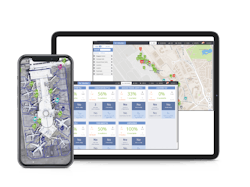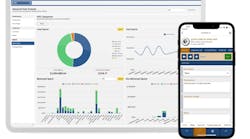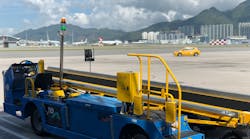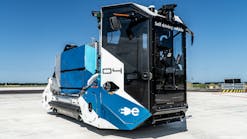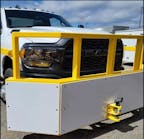To ensure ground handling teams are achieving on-time performance goals, and doing so safely, ground support equipment (GSE) uptime is key. Telematics solutions and data management platforms are aiding operational efficiency by allowing ground handling personnel to effectively communicate with GSE maintenance professionals.
For example, officials at EBIS, a Tronair Solution, explain that by using a telemetry platform with EBIS, along with its GPS capability, GSE can be located and important data like meter readings can be recorded.
This allows maintenance personnel to automatically schedule required maintenance for a specific piece of GSE.
“Telemetry is a complement to your GSE maintenance program,” explains Krystle Wittig, customer success manager at EBIS. “By installing telemetry on your equipment, EBIS has the ability to partner with the telemetry company to pull the selected data and the GPS location. One key highlight that is an immediate benefit for GSE technicians is the ability to identify where that piece of equipment is located on the airfield.”
Telematics technology allows users to get real-time data from the field and transmit it to the maintenance department, explains Matthias Moulinier, product and customer success director at Adveez. This allows the GSE team to react quickly when the level of a specific metric is not normal.
“This is creating a direct link between operations and the GSE team at the maintenance [shop],” he says.
Telemetry data is crucial for maintenance teams, agrees Santosh Nachu, general manager at EBIS. However, he says relying solely on telemetry overlooks the physical work done by technicians, which requires seamless and accurate data entry.
“Furthermore, with multiple telemetry providers and OEMs adding telemetry, it's impractical for asset owners to manage data across various platforms. An enterprise asset management (EAM) system like EBIS is essential for aggregating both user and telemetry data from multiple sources. Thus, providing decision makers with a single reliable source of truth,” Nachu says.
How Telematics Assist Ground Ops
When ground operations teams discover an issue – such as a dead battery, needed brake repairs, a broken starter, etc. – they need to be able to communicate that issue with GSE technicians.
An easy checklist with simple questions, accessible on a mobile phone, allows ground ops to report maintenance requests, Moulinier says.
“Adding a picture to the request is allowing the maintenance [team] to see the unit and the issue quickly,” he adds, pointing out visual components help technicians quickly understand the issue.
The EBIS Service Request function, according to company officials, allows the operations team to create a service request and send this request to the GSE maintenance team. GSE technicians can then decide if a work order is needed. This gives the GSE maintenance team control over the management of work orders, and they can align the work that needs to be done with the current schedule.
“To ensure that the GSE maintenance team has the most current information on a downed piece of equipment, information such as location, asset number, pictures, contact information and most importantly a detailed explanation for the team is needed to be able to fix and/or troubleshoot the equipment,” Wittig says.
“Some of this information can be captured via telemetry, such as GPS location. However, in partnership with a telemetry company having all the information in a single location, such as EBIS, will support the GSE technicians’ ability to reduce time in referencing multiple systems,” she adds.
EBIS officials explain the company’s platform integrates multiple telemetry vendors to consume data designed to improve overall asset management and preventative maintenance programs. EBIS can consume more than 1,000 data points, including key-on, in-gear, run hours, location, throttle percentage, DC voltage, battery management system (BMS) reading for electric vehicles and GPS location, among others.
What’s more, telemetry sensors are configurable to track sudden stops – and impacts – and an interactive map in EBIS can be reviewed to show where and when the impact occurred and who was operating the vehicle.
“Real-time data about trouble codes, metrics (i.e. hour meter, DEF level, e-stop, fuel level, oil pressure, battery temp, etc.) is data which can be retrieved and transferred quickly to maintenance,” Moulinier says.
“Having the pre-check list with a defined list of questions on top of a picture is part of global telematics solutions,” Moulinier says.
Telematics also prevent GSE from being used incorrectly.
“Driving behavior is also critical for maintenance,” Moulinier says. “If we detect harsh braking more often on a GSE, brakes should be checked more often on this specific GSE.”
How Telematics Assist Maintenance Efficiency
GSE maintenance teams can utilize captured data and telematics platforms to prevent future breakdowns, manage parts inventory, create and adjust preventative maintenance schedules and inform ground operations teams when equipment is in or out of service.
Technicians can utilize calendar- and meter-based work orders to ensure preventative maintenance and scheduled maintenance checks are not missed.
“With 10 years of data, we can now predict when a GSE is going to enter again in maintenance, depending on the brand/model,” Moulinier says. “AI algorithm is helping us to understand future breakdown schedules and make sure those GSE are already at the maintenance shop prior to the breakdown.”
“Being able to retrieve real-time engine hours is crucial to plan your maintenance based on real usage,” he adds.
EBIS officials note their platform allows users to dynamically update preventative maintenance schedules across multiple locations, providing visibility to the entire team.
Telemetry and data platforms also allow maintenance personnel to set up multiple inventory storerooms and have parts stocked as the schedule dictates. Technicians can deduct parts that are in the storeroom and view part availability, pricing and estimated delivery dates, which helps with planning and work order execution.
“With the checklist questions, telematics software can send notification to maintenance to order a new part number,” Moulinier points out.
Ground operations and GSE maintenance teams can view dynamic reports that show the allocation of equipment by location, including both the in-service percentage and out-of-service percentage of the fleet, EBIS officials explain. This dynamic dashboard allows users to drill down into multiple levels, so they can see the history of the maintenance on each piece of equipment.
Another key element to enhancing efficiency between ground ops and maintenance personnel is enabling mobile communication.
Mobile applications can also help ground ops and maintenance teams communicate effectively. EBIS officials say they support a mobile workforce, as the same EBIS capabilities are available in any browser on any device.
Moulinier notes operations teams can use mobile devices to report issues in real time to maintenance departments. And conversely, maintenance teams can alert the operations team when a GSE unit is repaired and available to operate.
